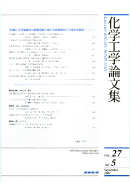Volume 27, Issue 5
Displaying 1-21 of 21 articles from this issue
- |<
- <
- 1
- >
- >|
Special Issue [Methods of Numerically Analyzing and Visually Measuring Transport Phenomena in Chemical Equipment]
-
2001 Volume 27 Issue 5 Pages 535-539
Published: September 20, 2001
Released on J-STAGE: December 30, 2008
Download PDF (2897K) -
2001 Volume 27 Issue 5 Pages 540-546
Published: September 20, 2001
Released on J-STAGE: December 30, 2008
Download PDF (1971K) -
2001 Volume 27 Issue 5 Pages 547-553
Published: September 20, 2001
Released on J-STAGE: December 30, 2008
Download PDF (1915K) -
2001 Volume 27 Issue 5 Pages 554-559
Published: September 20, 2001
Released on J-STAGE: December 30, 2008
Download PDF (2604K) -
2001 Volume 27 Issue 5 Pages 560-565
Published: September 20, 2001
Released on J-STAGE: December 30, 2008
Download PDF (2008K) -
2001 Volume 27 Issue 5 Pages 566-573
Published: September 20, 2001
Released on J-STAGE: December 30, 2008
Download PDF (3503K) -
2001 Volume 27 Issue 5 Pages 574-580
Published: September 20, 2001
Released on J-STAGE: December 30, 2008
Download PDF (2248K) -
2001 Volume 27 Issue 5 Pages 581-587
Published: September 20, 2001
Released on J-STAGE: December 30, 2008
Download PDF (2585K)
Transport Phenomena, Fluid Mechanics and Mixing
-
Article type: Fundamental Research Paper
Subject area: Transport Phenomena, Fluid Mechanics and Mixing
2001 Volume 27 Issue 5 Pages 636-641
Published: September 20, 2001
Released on J-STAGE: December 30, 2008
Download PDF (1839K) -
Article type: Note
Subject area: Transport Phenomena, Fluid Mechanics and Mixing
2001 Volume 27 Issue 5 Pages 657-660
Published: September 20, 2001
Released on J-STAGE: December 30, 2008
Download PDF (978K)
Catalysis, Kinetics and Reactor Design
-
Article type: Fundamental Research Paper
Subject area: Catalysis, Kinetics and Reactor Design
2001 Volume 27 Issue 5 Pages 624-628
Published: September 20, 2001
Released on J-STAGE: December 30, 2008
Download PDF (1576K) -
Article type: Note
Subject area: Catalysis, Kinetics and Reactor Design
2001 Volume 27 Issue 5 Pages 652-656
Published: September 20, 2001
Released on J-STAGE: December 30, 2008
Download PDF (1359K)
Materials and Devices
-
Article type: Fundamental Research Paper
Subject area: Materials and Devices
2001 Volume 27 Issue 5 Pages 629-635
Published: September 20, 2001
Released on J-STAGE: December 30, 2008
Download PDF (2709K)
Separations
-
Article type: Technical Research Paper
Subject area: Separations
2001 Volume 27 Issue 5 Pages 588-592
Published: September 20, 2001
Released on J-STAGE: December 30, 2008
Download PDF (1545K)
Particle Technology and Fluidization
-
Article type: Fundamental Research Paper
Subject area: Particle Technology and Fluidization
2001 Volume 27 Issue 5 Pages 610-615
Published: September 20, 2001
Released on J-STAGE: December 30, 2008
Download PDF (1934K) -
Article type: Note
Subject area: Particle Technology and Fluidization
2001 Volume 27 Issue 5 Pages 648-651
Published: September 20, 2001
Released on J-STAGE: December 30, 2008
Download PDF (1353K)
Process System Engineering
-
Article type: Fundamental Research Paper
Subject area: Process System Engineering
2001 Volume 27 Issue 5 Pages 642-647
Published: September 20, 2001
Released on J-STAGE: December 30, 2008
Download PDF (1684K)
Safty, Enviroment and Energy
-
Article type: Fundamental Research Paper
Subject area: Safty, Enviroment and Energy
2001 Volume 27 Issue 5 Pages 593-598
Published: September 20, 2001
Released on J-STAGE: December 30, 2008
Download PDF (1720K) -
Article type: Fundamental Research Paper
Subject area: Safty, Enviroment and Energy
2001 Volume 27 Issue 5 Pages 599-603
Published: September 20, 2001
Released on J-STAGE: December 30, 2008
Download PDF (1207K) -
Article type: Fundamental Research Paper
Subject area: Safty, Enviroment and Energy
2001 Volume 27 Issue 5 Pages 604-609
Published: September 20, 2001
Released on J-STAGE: December 30, 2008
Download PDF (1660K) -
Numerical Analysis of Reaction Mechanism of Selective Non-Catalytic NO Reduction using Urea SolutionArticle type: Fundamental Research Paper
Subject area: Safty, Enviroment and Energy
2001 Volume 27 Issue 5 Pages 616-623
Published: September 20, 2001
Released on J-STAGE: December 30, 2008
Download PDF (2339K)
- |<
- <
- 1
- >
- >|
